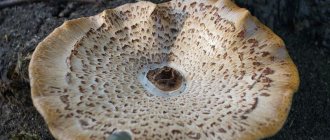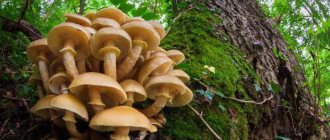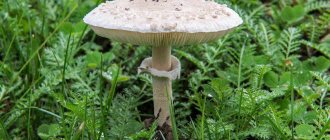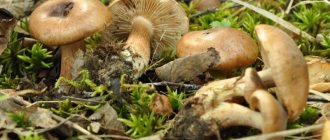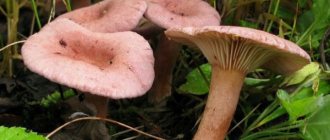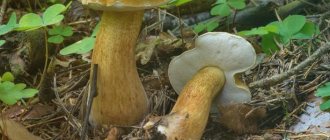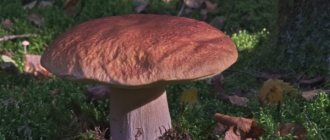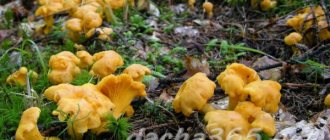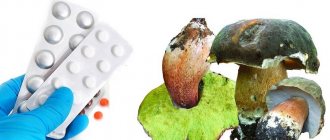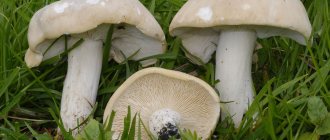It is a key ingredient in many gourmet dishes - side dishes, appetizers, soups and even desserts. Moreover, this mushroom has a number of useful properties: it is characterized by high energy value, in addition, it is used for medical purposes as an antibacterial agent. We are talking about champignon - a representative of agaric mushrooms that have been cultivated for two centuries in many parts of the planet.
Champignon
Despite the fact that humanity has been dealing with this “forest delicacy” for quite a long time, many cases of poisoning regularly occur.
Look carefully at the photos of the most dangerous false champignons and remember their description: the pale toadstool and fly agaric look very much like edible species, but some 70-90 g is enough for an adult man or woman to at least end up in intensive care.
It is quite easy to confuse a poisonous specimen with one that can be eaten without hesitation. That is why experts insist that novice mushroom pickers must learn to distinguish one from the other.
Species such as yellow-skinned, Californian and motley are more likely than others to cause harm to the health of gourmets. To know exactly how to determine that these are representatives of inedible false champignons, you need to carefully examine them.
Firstly, the round caps of these varieties will have a diameter of approximately 15 cm, and you can easily see brown and brown shades inside them. Secondly, if you press on the top of the poisonous species, a yellowish liquid will come out charmingly.
This is precisely the indicator that these mushrooms are not suitable for cooking.
Moreover, when breaking false champignons, a characteristic sourish smell often appears, and not almond or anise, as in edible specimens.
Types of edible champignons
In total, the scientific classification identifies about 200 types of different champignons, of which a relatively small part is unsuitable for consumption. There are very few of them that are poisonous. Such favorable conditions, combined with the ease of artificial cultivation, are the reason that currently more than 1/3 of all artificially grown mushrooms in the world are champignons. In Russia this figure is much higher – more than 70%. Below are photos and descriptions of some false and real champignons.
Champignons are the most commonly used mushrooms in cooking.
Depending on the growing conditions, all champignons are divided into 5 main groups:
- Forest.
- Growing in open spaces.
- Grows only in grass.
- Growing in grass and forests.
- Desert.
The most famous edible species are the following.
- Champignon bisporus. This is an edible mushroom I, the highest category, it is also called cultivated, cultivated or garden champignon. It grows from late spring to autumn on cultivated soils rich in organic matter, and is found in gardens and pastures. The mushroom cap resembles a hemisphere with the edge turned inward. Its diameter usually ranges from 5 to 15 cm, although larger specimens are also found. The color is light brown, richer in the center, with visible radial fibers or scales. On the reverse side of the cap there are numerous thin plates. Their color changes depending on the age of the mushroom, from pinkish to brown, and later dark brown with a purple tint. The stem of the mushroom is dense, solid, 3-8 cm long, cylindrical, smooth, usually painted the same color as the cap. The flesh of the mushroom turns slightly pink when cut. It has a pleasant mushroom aroma and good taste.
- Field champignon (sheep, common). Found throughout Russia. It grows from the end of May until the onset of cold weather in the grass in open spaces, meadows, gardens and parks, and is found on forest edges and clearings. The young field champignon has a hemispherical cap, which, as the mushroom grows, first becomes umbrella-shaped and then almost flat. Its upper part is white, shiny, velvety to the touch. Numerous plates are located below, covered with a blanket in young mushrooms. Their color changes with the age of the mushroom; in young specimens they are grayish, then turn pink, and then become brown with a chocolate tint. The leg is white, cylindrical, strong, the ring is two-layered, hanging down. The flesh is white, turning yellow when broken. Experienced mushroom pickers can easily recognize this champignon by its characteristic anise smell.
Important! Many experienced mushroom pickers consider this type of champignon to be the most delicious and valuable.
- Common champignon (real, meadow, pecheritsa). It can be found from late May to mid-autumn in open grassy areas, meadows, steppes, cultivated lands, near roads, farms, and residential buildings. At a young age, this type of champignon has a spherical and then hemispherical cap, which over time takes on a prostrate shape. It is light brown, dry, pleasant to the touch. On the reverse side there are thin, numerous plates that change color from white to pinkish as they grow; later they become increasingly darker and become chocolate brown, and in adulthood they acquire a dark brown color with a purple tint. The mushroom stem is straight, cylindrical, white, dense. In its middle part there is usually a wide thin ring. The flesh at the cut or break first becomes pink and then turns red. Common champignon is widely used in cooking; it can be used in any form. In terms of the content of useful substances, it is comparable to porcini mushroom.
A short video about how the common champignon grows in the wild: - Large-spored champignon. This species is widespread in Central, Western and Southern Europe; in Russia it is found only in some southern regions. It is distinguished by its large size, for example, the cap can reach 0.5 m in diameter. It is rounded-convex, fibrous, white, with fine fringe at the edges, and becomes covered with scales with age. The plates located on the back side of the cap are small, thin, light pink in young mushrooms, brown in old mushrooms. The leg is white, rather short and thick, massive. The ring is single, with clearly visible scales on the bottom. The pulp is dense, white, and slowly turns red when mechanically damaged. Young large-spored champignon has a pronounced almond aroma, but with age the smell begins to resemble ammonia. Has excellent taste.
In addition to the listed types of champignons, there are many others that have lower nutritional value, but are suitable for consumption.
Places of growth
The yellow button mushroom can be found throughout Britain and Ireland, as well as other European countries from northern Scandinavia to the Mediterranean. This fungus has also been reported in North America, occurring in Australia where it is an introduced species and is reported to be a very common cause of mushroom poisoning. It can be found under coniferous and deciduous trees, in the grass and in gardens. The mushroom bears fruit throughout the year when there is moisture. It is a saprobic fungus that lives on dead and decaying organic matter. It grows in rings and partial arcs, but single specimens or small groups of mushrooms are often found.
What mushrooms are similar to champignons?
Champignons are lamellar mushrooms. At a young age, many species from this class have a hemispherical or spherical shape, which is always fraught with confusion in their visual identification. The greatest similarity with edible mushrooms is their false counterparts - inedible champignons.
In addition to related species, other mushrooms are similar to champignons, especially at the initial stage of development. What's especially dangerous is that some of the false doubles are deadly poisonous.
What do false champignons look like?
Some inedible counterparts from the Agarikov family, i.e., their closest “relatives,” have the greatest visual resemblance to edible champignons. Here is a photo and description of some false champignons:
- Red-colored champignon (yellow-skinned pepper). This false double of the edible champignon has a semicircular cap at a young age, and in a later period of development a bell-shaped cap with scales up to 15 cm in diameter. The color of its upper part is white with a characteristic uneven coffee-brown spot in the center. On the reverse side there are small, even plates that change color with age from white, first to pink, and then to brown. The leg of this double is white, hollow, and has a tuber at the base. The ring is wide, white, two-layer. The pulp is brownish in color and turns yellow if mechanically damaged. Emits a characteristic “chemical” smell of phenol, which intensifies when heated. The mushroom is common in many regions and can be found in mixed forests, as well as in gardens and parks. It grows from the 2nd half of summer until mid-autumn. This false double should not be eaten; if it enters the body, it causes poisoning and intestinal disorders. Despite this, the mushroom is considered medicinal and is used in folk medicine.
- Variegated champignon (Mellera, scaly). In young mushrooms the cap is rounded, in adults it becomes flat and spread. From above it looks spotted due to the large number of detached scales of gray or ash-brown color. Their greatest density is in the center; there are few scales on the periphery of the cap, so the color there is almost white. On the reverse side of the cap of this false double there are numerous even thin plates; in a young mushroom they are pale pink, and as they grow they darken and acquire a chocolate color. The stem is cylindrical, dense, white, and as the mushroom grows it first turns yellow and then brown. The ring is dense, pronounced. The flesh is white at the break and quickly turns brown. Has an unpleasant smell. This false twin is widespread in the southern regions, grows in steppes and forest-steppes, and is sometimes found in parks. The toxicity of the variegated champignon is assessed differently in various sources; in some it is indicated as poisonous, while in others this feature is not noted. With a high degree of probability, this indicator depends on the place where the mushrooms grow and the individual tolerance of the human body that consumed them.
- California champignon. The cap of this false double is round at an early stage of growth, later spread out, dry, light brown with a metallic tint, darker in the center and lighter at the periphery. The plates on the reverse side are white, smooth, acquire a pinkish tint with age, and then become chocolate brown. The leg is cylindrical, often curved, with a ring. At the cut site, the flesh slowly darkens. This false champignon emits an unpleasant smell of phenol, is poisonous and is not eaten.
- Flat-headed champignon. This false twin is often found in deciduous and mixed forests of the temperate zone, and can often be seen next to veins and buildings. The cap at a young age is ovoid; in an adult mushroom it gradually straightens out and becomes almost flat, with a small tubercle in the center. The upper part is covered with numerous gray scales, more densely in the center and less intensely at the periphery. The plates located on the back side of the cap are slightly pinkish when young, but as the mushroom ages they darken and become dark brown, almost black. The leg is white, cylindrical, with a pronounced ring in the middle part. The pulp is white, when damaged it turns yellow and then turns brown. Emits an unpleasant “chemical” odor of carbolic acid. According to some estimates, the flat-head champignon is classified as conditionally edible; according to others, this false double is considered mildly poisonous, causing intestinal disorders.
Photos and descriptions of other false champignons can be found in specialized literature.
Application
Yellow-skinned champignon is used exclusively as a medicinal plant in folk medicine. It contains natural antibiotics agaricin and psalliotin, with which you can resist gram-positive bacteria and salmonella. According to some scientists, the chemical substances found in the yellow-skinned liverwort, when used correctly, can help in the fight against cancer.
Important! The information presented in the material is for informational purposes only. Before use, be sure to consult a specialist.
Poisonous mushrooms similar to champignons
Edible champignons can be confused not only with false counterparts from their family, but also with some truly deadly poisonous mushrooms, especially when young. Here are the most dangerous of them.
Death cap. At a young age, it can easily be confused with champignon; this is the most dangerous of its twin mushrooms.
The differences between the pale grebe are as follows:
- At the bottom of the leg there is a tuberous thickening.
- The plates remain completely white at any age.
- Absent.
The fly agaric is smelly. In appearance, this deadly mushroom is very similar to champignon, however, it also has its own distinctive characteristics.
Here are the main differences between the stinking fly agaric.
- Sticky, slimy, bell-shaped cap.
- Scaly foot.
- Presence of volva (tuber).
- White regardless of the age of the record.
- Unpleasant chlorine smell.
White fly agaric. This mushroom is also deadly poisonous.
The differences between white fly agaric and champignon are as follows.
- The mushroom is completely white.
- The plates are always white and do not change color with age.
- There is a pronounced volva.
- Emits an unpleasant odor.
Important! When collecting champignons in the forest, you need to be absolutely confident in your ability to distinguish them from false, and even more so poisonous, doubles. A mistake can cost your life.
conclusions
- Even the most harmless mushroom, as it may seem at first glance, can have a dangerous double.
- Now you know how to distinguish champignons from false champignons. Particular attention is paid to the smell, the location of the cut of the lower part of the cap mushroom and heat treatment.
- When consumed, fakes can lead to severe intoxication of the body. At the first signs, you should immediately contact a medical facility.
- If you look for mushrooms in an ecologically clean area and apply safety measures, you will be able to please yourself and your loved ones with a delicious dish, and in winter - with nutritious pickles.
Symptoms of poisoning, first aid
Cases of poisoning by poisonous mushrooms mistakenly taken for champignons are recorded annually. Unfortunately, a significant proportion of such cases end tragically. In this regard, the most dangerous is the mistaken consumption of toadstool, one of the poisonous counterparts of the champignon. Unlike other poisonous fly agarics similar in appearance, the pale grebe has no odor, so it is almost impossible to recognize it by this characteristic.
The clinical picture of toadstool poisoning appears with a long delay, which makes timely diagnosis and initiation of treatment difficult. The first symptoms may appear only after a day, and in some cases even more. Here are the main signs of toadstool poisoning.
- Colic, cramps and cramps in the stomach.
- Nausea, constant vomiting.
- Diarrhea.
- Deterioration of general condition, weakness.
- Arrhythmia.
- Constant thirst.
- Impaired consciousness.
As a rule, on the 3rd day after poisoning there is an improvement in well-being, but this is only an appearance that the body has coped with the poisoning. The destructive effect of toxins continues at this time. After 2-4 days, the function of the liver and kidneys is impaired, jaundice develops, and the structure of the blood changes. In most cases, death from acute cardiac, renal or liver failure follows on days 10-12.
In case of poisoning with poisonous mushrooms, urgent hospitalization is required
In case of poisoning with toadstool, it is very important to start treatment as early as possible. This is not a guarantee of recovery, but it gives a chance. If urgent measures are not taken, 90% of poisoning cases end in the death of the victim. Therefore, if you suspect poisoning, you need to take the poisoned person to the nearest hospital as soon as possible or call a doctor at home. Before his arrival, the victim’s stomach should be rinsed, forcing him to drink a large amount of lightly salted water, and then induce vomiting. You should also give him activated carbon (1 tablet for every 10 kg of weight) or another enterosorbent.
Season and collection rules
In a temperate climate zone, you can start collecting the mushrooms in question from the end of May, continuing to look for them until October or even November.
The optimal ripeness of a champignon for harvesting can be determined by the film connecting its stem and cap: it is better to harvest when it is already well stretched, but has not yet had time to burst (the diameter of the dome is 4–10 cm). Such specimens will be as meaty and tasty as possible, which is what a mushroom picker needs. Of course, it is better not to take damaged and unpleasant-smelling mushrooms, but healthy and evenly colored ones can be carefully twisted out of the soil. Unlike most other forest mushrooms, there is no need to cut field champignons, which is due to the structural features of the plant’s mycelium. The remaining holes should be filled with substrate, after removing all remnants of the previous harvest or remaining unsuitable specimens.
Did you know? Home cultivation of champignons in Europe began in the 17th century. Back then it was considered a delicacy and was grown in underground premises that belonged mainly to monarchs. In Russia, this practice became relevant only in the 18th century.

